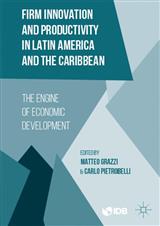El sistema argentino de innovación: Determinantes micro y desarticulación meso-macro. pp 97-124

Integrantes: Diana Suarez | Gabriel Yoguel | Verónica Robert
Florencia Barletta
Abstract: La historia argentina del último siglo reconoce cuatro modelos de crecimiento: i) el modelo agroexportador entre 1880 y 1930, ii) la industrialización por sustitución de importaciones desde 1930 hasta 1975, iii) el modelo neoliberal, instrumentado desde la última dictadura militar y profundizado durante los 90, luego de un impasse proteccionista resultado de la escasez de divisas y de intentos de política industrial que coincidió con el retorno a la democracia, y iv) la post-convertibilidad, iniciada con la devaluación de la moneda en 2002 que se caracteriza por un tipo de cambio alto con retenciones a las exportaciones que favoreció el desarrollo del mercado interno y el consumo. En cada período histórico, el rol del Estado,
los incentivos productivos y la relación de la Argentina con el resto del mundo marcaron el sentido del cambio tecnológico y contribuyeron a moldear el perfil de especialización actual.
Es por ello que a pesar de los cambios estructurales que imprimió cada modelo de crecimiento, persisten patrones de conducta resultado de la convergencia de procesos históricos e incentivos macro, determinados no sólo por las decisiones individuales sino también por la agregación de comportamientos colectivos.
Acceder: Link de redirección
Recomposición del capital y respuestas sindicales en Argentina ¿Hacia nuevas relaciones laborales?
Neodesarrollismo argentino. Un análisis de la economía argentina entre 2003 y 2012: novedades macroeconómicas y continuidades estructurales”
Primera parte pág. 15-46
Integrante: Pinazo, Germán
Abstract: El objetivo de estas páginas es analizar algunos rasgos de la acumulación del capital en la Argentina contemporánea (2003-2012). Más específicamente, intentaremos contribuir al conocimiento de qué se produce en el capitalismo argentino, quiénes lo producen y cómo; prestando especial atención esquemáticamente a algunas cuestiones básicas: el lugar del capitalismo argentino en la división internacional del trabajo, y ciertos indicadores fundamentales de la relación capital-trabajo (la evolución de la dinámica del empleo asalariado, de la ganancia capitalista y del salario). Es importante señalar que, en el período analizado, la economía argentina ha evidenciado ciertos desempeños inéditos, que han abierto nuevos debates y hacen especialmente relevante el objetivo de este trabajo. No sólo se han alcanzado records en materia de crecimiento económico, sino que este crecimiento ha estado motorizado en muchos años (como hace décadas no sucedía) por la actividad manufacturera, en un proceso que ha derivado en una dinámica también inédita en materia de generación de empleo. Sintéticamente el trabajo intentará mostrar cómo la economía argentina de los últimos años ha combinado esta novedosa dinámica macroeconómica con fuertes continuidades estructurales, en términos de sus agentes predominantes, sus actividades productivas y de la relación capital-trabajo; presentando datos e interpretaciones que, a nuestro modo de ver, son novedosas en muchos sentidos.
Acceder: Link de redirección
The Financialization Response to Economic Disequilibria: European and Latin American Experiences
The periphery and globalised production: A new dependency?
Chapter 4
Integrantes:
Cibils, Alan
Pinazo, Germán
Abstract
In this chapter we analyse the role of periphery countries in what has been called the new international division of labour from two perspectives. First we look at the theoretical debates centred on new growth theory, neostructuralism, and the renewed interest in structuralist and dependency theories. Second, we present and analyse a broad range statistical aggregates. Our analysis leads us to conclude that there is justification for the use of dependency concepts for periphery countries in today’s international division of labour.
Acceder: Link de redirección
Development Economics for the XXI Century
The resurgence of dependency analysis: Nostalgia or renewed relevance
Chapter 6
Integrante: Cibils, Alan
Abstract: The post-war years produced two highly influential currents of thought in Latin America. With epicentre in the Economic Commission for Latin America and the Caribbean (CEPAL, according to its name in Spanish), first structuralism and then dependency analyses provided original theories of the development process. A key component of these analyses was the centre-periphery paradigm, according to which countries in the periphery were not just backward, needing to “catch up” to the centre. Rather, centre and periphery were part of a global capitalist system that reproduced unequal relations between centre and periphery countries. The end of the Breton Woods system in the early 1970s and the rise of monetarism produced radical changes in academic and policy circles around the world. In Latin America, a series of bloody military coup d’état’s did away with CEPAL-inspired developmentalist economic policies replacing them with a wide range of “market friendly” policies. After four decades of neoliberal policies, it is clear that they have not delivered as promised. Cyclical financial crises, erratic growth, rising inequality and social exclusion, and very uneven development processes in the periphery have led many social scientists to “re-discover” the Latin American structuralist and dependency traditions and re-evaluate structuralist and dependency concepts on development and underdevelopment. This paper provides first a historical overview of the emergence of structuralism and dependency analyses and some of the reasons why these theories never became fully accepted in the centre’s economics academe. This overview is followed by a discussion of current applications of dependency analyses in the traditional periphery and also in the new peripheries of Europe and within centre countries. The paper concludes with some general remarks about dependency’s renewed relevance in the aftermath of neoliberal globalisation.
Acceder: Link de redirección
TÓPICOS EMERGENTES E DESAFIOS METODOLÓGICOS EM ENGENHARIA DE PRODUÇÃO: CASOS, EXPERIÊNCIAS E PROPOSIÇÕES – Volume VIII
Reflexões sobre a contribuição dos programas de intercâmbio internacional para a área de Engenharia de Produção
CAPÍTULO 3
Fernando Cusolito
Franco Chiodi
INTRODUÇÃO
A internacionalização da educação superior, movimento que já é comum na Europa e na América do Norte, tem crescido significativamente na América Latina (BERRY; TAYLOR, 2014; LUIJTEN-LUB; VAN DER WENDE; HUISMAN, 2005).
No Brasil, tem-se verificado nos últimos anos um crescimento exponencial das oportunidades dos estudantes e pesquisadores em participarem de programas de intercâmbio internacional. Dentre os principais programas podem-se destacar o Ciência sem Fronteiras – CsF (com abrangência global), Programa Santander Universidades Mobilidade Internacional (com abrangência global), Erasmus Mundus – BEMundus (consórcio entre instituições brasileiras e europeias), Associação das Universidades do Grupo Montevideo – AUGM (consórcio entre instituições da América do Sul), Grupo Tordesillas (consórcio entre instituições brasileiras, ortuguesas e espanholas), BRAFITEC (cooperação bilateral entre Brasil e França), entre outros. Em geral, os programas acontecem por meio de cooperação bilateral entre países ou instituições, ou ainda por meio de cooperação em projetos de pesquisa.
Acceder: Link de redirección
Firm Innovation and Productivity in Latin America and the Caribbean
 Business Performance in Young Latin American Firms. Chapter 6
Business Performance in Young Latin American Firms. Chapter 6
Hugo Kantis | Juan Federico | Pablo Angelelli | Sabrina Ibarra García
Introduction: Aggregate data on productivity growth only accounts for a partial view of the Latin American reality. Indeed, one of the most salient features of business structures in the region is the presence of a high degree of heterogeneity across firms. As far as productivity is concerned, a large base of micro and small firms with low levels of productivity coexist alongside a select group of large firms, including subsidiaries of transnational companies, characterized by very high levels of productivity (Pagés, 2010). As mentioned in the introduction to this book, it is very important to understand the sources of this heterogeneity and to identify ways to reduce the productivity gap. One interesting dimension that deserves attention is firm age. In particular, the extent to which young firms can act as vehicles for reducing productivity gaps, as young firms are often considered a potential source of economic innovation, rejuvenation, and renewal. This expectation has motivated different studies in Europe and worldwide (Pellegrino, et al. 2012; Schneider and Veugelers, 2010; Ayyagari, et al., 2011).
Acceder: Link de redirección









 Business Performance in Young Latin American Firms. Chapter 6
Business Performance in Young Latin American Firms. Chapter 6